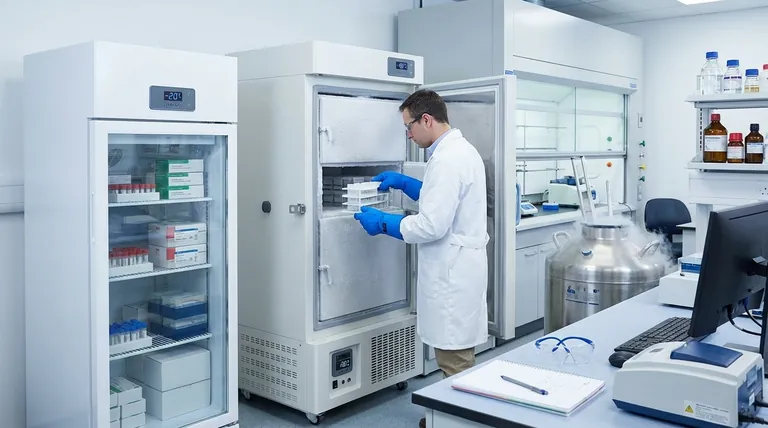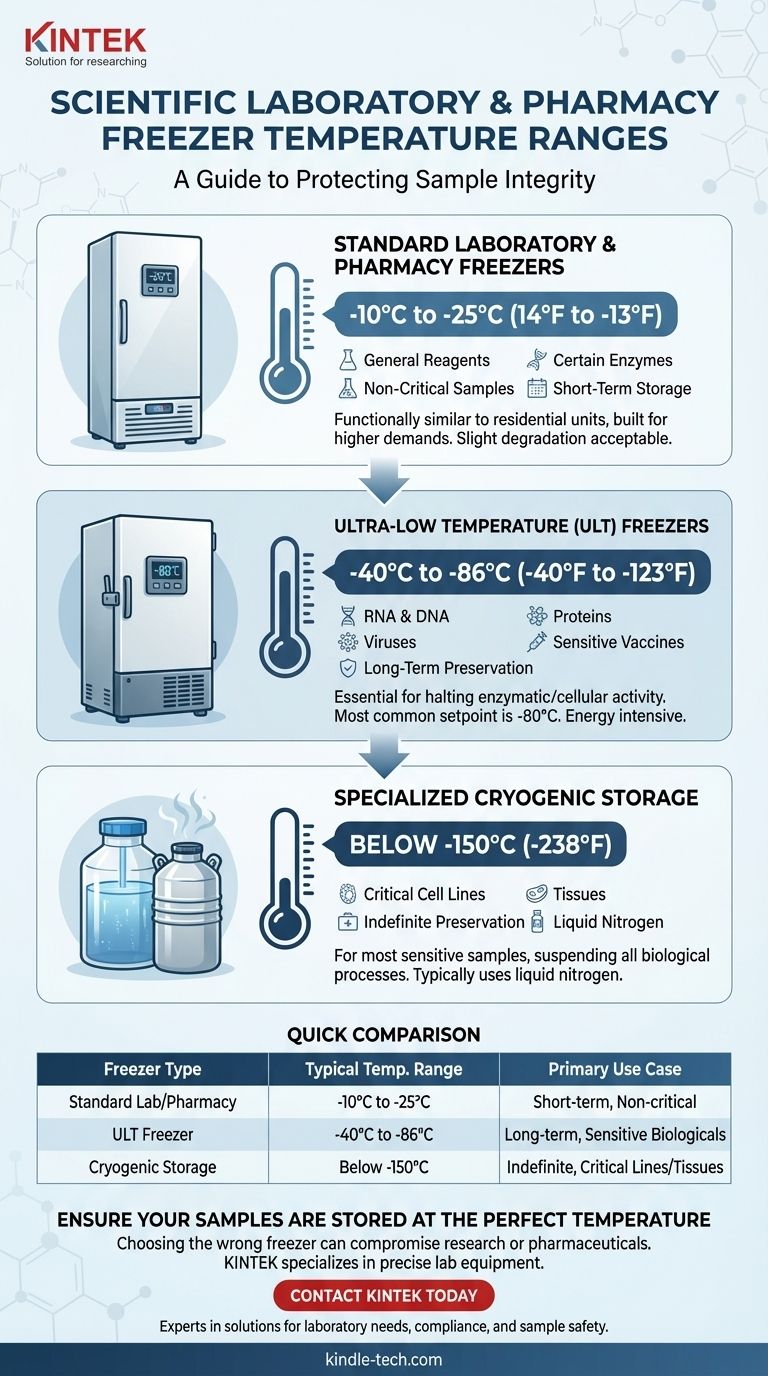For a standard scientific or pharmacy freezer, the typical controlled temperature range is from -10°C to -25°C (14°F to -13°F). However, this only represents one category of laboratory cold storage, as specialized units like Ultra-Low Temperature (ULT) freezers are required for more sensitive materials.
The term "laboratory freezer" encompasses distinct classes of equipment. Understanding the difference between a standard freezer (-10°C to -25°C) and an Ultra-Low Temperature (ULT) freezer (-40°C to -86°C) is critical for ensuring sample integrity and stability.

The Primary Classes of Laboratory Freezers
Not all scientific samples require the same level of cold. The freezer category you need is dictated entirely by the material you intend to store, as different temperatures halt biological and chemical activity to varying degrees.
Standard Laboratory & Pharmacy Freezers (-10°C to -25°C)
This is the most common type of freezer found in a lab or pharmacy setting. It is functionally similar to a residential freezer but built for the higher demands of a professional environment.
These units are ideal for the short-term storage of general reagents, certain enzymes, and non-critical biological samples where slight degradation over time is not a primary concern.
Ultra-Low Temperature (ULT) Freezers (-40°C to -86°C)
ULT freezers are a specialized class designed for the long-term preservation of highly sensitive biological and chemical materials.
Maintaining temperatures between -40°C and -86°C is essential for halting nearly all enzymatic or cellular activity. The most common setpoint for these units is -80°C.
Specialized Cryogenic Storage (Below -150°C)
For the most sensitive samples, such as cell lines or critical tissues requiring indefinite preservation, even ULT temperatures are insufficient.
These applications rely on cryogenic storage, typically using liquid nitrogen to maintain temperatures at or below -196°C, effectively suspending all biological processes.
Why the Correct Temperature Range is Critical
Choosing the wrong storage temperature can irrevocently damage or destroy valuable samples, leading to wasted research, invalid results, or ineffective medical treatments.
Preserving Sensitive Biological Samples
Materials like RNA, DNA, proteins, and viruses are extremely fragile. At standard freezer temperatures, residual enzymatic activity can slowly degrade them.
ULT freezers are required to halt this molecular activity, ensuring the samples remain unchanged for years.
Maintaining Vaccine and Reagent Stability
Many modern vaccines, including certain COVID-19 vaccines, and complex chemical reagents require precise ultra-low temperatures to maintain their structure and efficacy.
Storing them in a standard -20°C freezer would render them useless. This requirement is often specified by regulatory bodies like the CDC.
Understanding the Trade-offs
While colder is often better for preservation, it comes with significant practical and financial considerations.
Energy Consumption and Cost
ULT freezers are energy-intensive. Maintaining a stable temperature of -80°C requires a powerful compressor and robust insulation, leading to significantly higher electricity consumption and upfront purchasing costs compared to standard models.
Sample Accessibility and Management
Opening a ULT freezer must be a quick and deliberate action. Each opening introduces warmer, moist air, causing temperature fluctuations and frost buildup that can compromise other samples and strain the equipment.
Making the Right Choice for Your Application
To select the appropriate equipment, you must first define the stability requirements of the materials you will be storing.
- If your primary focus is general reagents and non-critical samples: A standard laboratory freezer operating between -10°C and -25°C is the most practical and cost-effective choice.
- If your primary focus is long-term preservation of sensitive biologicals (DNA, RNA, proteins, or viruses): An Ultra-Low Temperature (ULT) freezer in the -40°C to -86°C range is non-negotiable.
- If your primary focus is the indefinite storage of critical cell lines or tissues: You must use specialized cryogenic systems, typically involving liquid nitrogen.
Ultimately, matching the freezer's capability to the scientific need is fundamental to reliable and reproducible results.
Summary Table:
| Freezer Type | Typical Temperature Range | Primary Use Cases |
|---|---|---|
| Standard Lab/Pharmacy Freezer | -10°C to -25°C (14°F to -13°F) | Short-term storage of general reagents, enzymes, non-critical samples |
| Ultra-Low Temperature (ULT) Freezer | -40°C to -86°C (-40°F to -123°F) | Long-term preservation of sensitive biologicals (DNA, RNA, proteins, vaccines) |
| Cryogenic Storage | Below -150°C (-238°F) | Indefinite preservation of critical cell lines and tissues |
Ensure Your Samples are Stored at the Perfect Temperature
Choosing the wrong freezer can compromise years of research or render valuable pharmaceuticals ineffective. KINTEK specializes in providing the precise lab equipment you need, from reliable standard freezers to high-performance ULT units, ensuring your sensitive materials maintain their integrity.
Let our experts help you select the ideal freezer for your specific application. We provide solutions tailored to laboratory needs, guaranteeing compliance, efficiency, and sample safety.
Contact KINTEK today for a personalized consultation and protect your critical work.
Visual Guide

Related Products
- 108L Vertical Ultra Low Temperature ULT Freezer
- 28L Compact Upright Ultra Low Temperature Freezer for Laboratory
- 508L Advanced Vertical Ultra Low Temperature Freezer for Critical Laboratory Storage
- 938L Vertical Ultra Low Temperature Freezer for Advanced Laboratory Storage
- 608L Essential Laboratory Ultra Low Temperature Freezer For Critical Sample Preservation
People Also Ask
- What are the common applications of ultra-low temperature freezers? Preserve Your Most Valuable Samples
- Where are ultra low temperature freezers commonly used? Essential for Labs, Hospitals, and Biotech
- What makes Ultra-Low Temperature freezers energy efficient? Key Design & Operational Strategies
- What temperature range do Ultra-Low Temperature freezers maintain? The -80°C Standard for Sample Integrity
- What factors should be considered when selecting an ultra-low temperature freezer? Ensure Sample Integrity and Long-Term Value



















